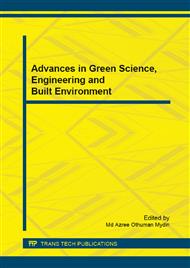p.221
p.226
p.230
p.234
p.238
p.242
p.246
p.250
p.257
Polyacrylate Modified Binder for Sustainable Asphalt Pavement Performances Using Superpave Mix Design
Abstract:
Sustainable asphalt pavement is important in decreasing material costs by improving the existing material such as modified asphalt binders. It is also needed to provide a quality riding for road users. In achieving quality riding, the material selection and mix design must be correctly examined before using in pavement construction. Then, the aims of this study are to determine suitability of material selected by examining the aggregate properties and modified asphalt binder. In modified asphalt binder, 6% of polyacrylate polymer was added as an additive in 500g of binder content to dissolve. It was checked through Superpave gyratory compactor in determining air voids samples in term of height after compacted. The samples were mixed with different percentages of binder content; 5%, 5.5%, 6% and 6.5% to produce control and polyacrylate modified samples. 8 gyratory for Ninitial and 100 gyratory for Ndesign were used in compaction of samples to determine air voids in term of height. The results show that 5.5% of binder content of polyacrylate modified samples has lower air voids compare than control samples. Thus, modified binders are able to minimize binder usage and save natural sources and also cost by improving bonding between mixtures to prevent pavement failure
Info:
Periodical:
Pages:
238-241
Citation:
Online since:
March 2015
Authors:
Price:
Сopyright:
© 2015 Trans Tech Publications Ltd. All Rights Reserved
Share:
Citation:


